
Organic reaction mechanisms. 1998 / 14
.pdf
Organic Reaction Mechanisms - 1998: An Annual Survey Covering the Literature Dated December 1997 to November 1998. Edited by A. C. Knipe and W. E. Watts Copyright ∂ 2003 John Wiley & Sons, Ltd.
ISBN: 0-471-49017-2
CHAPTER 14 |
|
Addition Reactions: Cycloaddition |
|
N. DENNIS |
|
University of Queensland, PO Box 6382, St. Lucia, Queensland 4067, Australia |
|
2 +2-Cycloaddition . . . . . . . . . . . . . . . . . . . . . . . . . . . . . . . . . . . . . . . . . . |
453 |
2 +3-Cycloaddition . . . . . . . . . . . . . . . . . . . . . . . . . . . . . . . . . . . . . . . . . . |
457 |
2 +4-Cycloaddition . . . . . . . . . . . . . . . . . . . . . . . . . . . . . . . . . . . . . . . . . . |
466 |
Miscellaneous Cycloadditions . . . . . . . . . . . . . . . . . . . . . . . . . . . . . . . . . . . |
478 |
References . . . . . . . . . . . . . . . . . . . . . . . . . . . . . . . . . . . . . . . . . . . . . . . . |
481 |
Density functional theory and MC-SCF calculations have been applied to competing concerted and stepwise mechanisms of cycloaddition reactions.1
Diphenylketene undergoes 2 + 2- or 2 + 4-cycloaddition reactions with various 1,3- diazabuta-1,3-dienes.2 The 2 + 4-, 4 + 2-, 6 + 4- and 8 + 2-cycloaddition reactions of heptafulvenes have been reviewed.3
The acceleration effect on 4 + 2-, 3 + 2- and 2 + 2-cycloadditions in the presence of aluminium, gallium and boron halides is due to the increase of π -acceptor properties of the dienophiles.4
2-Methoxycarbonyl-5-methyl-3,4-diphenylcyclopentadienone (1) undergoes 4 + 2- and 4 + 6-cycloadditions with a variety of dienophiles (Scheme 1).5
The reaction of 1,4-diphenylbuta-1,3-diene (2) with trithiazyl trichloride (3) yields a bi(thiadiazole) (4), an isothiazoloisothiazole (5), a dithiazolothiazine (6), and two thiazinodithiatriazepines (7) and (8) by 1,2-, 1,3-, and 1,4-cycloaddition reactions (Scheme 2).6 The bridged-mode (β-tether) tandem inter-[4 + 2]/intra-[3 + 2] cycloaddition of (E)-2-methyl-2-nitrostyrene (9) with 1-butoxypenta-1,4-diene (10) produces stable tricyclic nitroso acetals (11) which afford, after reduction and protection, highly func-
tionalized aminocyclopentanedimethanol triacetates (12) (Scheme 3).7,8
2 +2-Cycloaddition
The mechanisms of regioselective and stereoselective 2 + 2-photocycloadditions have been extensively reviewed.9 The intramolecular 2 + 2-photocycloaddition of 2-allyl- 2-(1H )-naphthalenone (13) on the surface of silica produces all four cycloadducts (14)–(17) (Scheme 4).10 Molecular mechanics have been used to study the regioand stereo-selectivity of the 2 + 2-photocycloadditions in complexes containing crown ether styryl dyes and alkaline earth metal cations.11
453
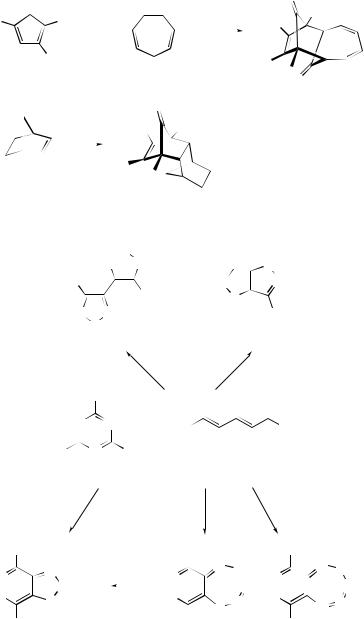
454 |
Organic Reaction Mechanisms 1998 |
|
O |
|
|
|
|
|
|
|
|
|
|
|
|
O |
||
Me |
|
CO2Me |
|
|
|
|
|
|
|
|
|
Me |
||||
|
+ |
|
|
|
|
CHCl3 |
|
|
Ph |
|
||||||
|
|
|
|
|
|
|||||||||||
|
|
|
|
|
|
|
|
|
|
|
50 °C, 2 d |
|
|
|
||
|
|
|
|
|
|
|
|
|
|
|
|
|
|
|
||
Ph |
|
Ph |
|
|
|
|
|
|
|
|
|
|
|
|
Ph |
|
|
|
|
|
|
|
|
|
|
|
|
|
|
||||
|
(1) |
|
|
|
|
|
|
O |
|
|
|
|
MeO2C |
O |
||
|
|
|
|
|
|
|
|
|
|
|
|
|
|
|||
|
+ |
|
|
|
|
|
|
|
O |
|
|
|
|
|
|
|
|
|
|
|
50 °C |
|
Ph |
Me |
|
|
|
||||||
|
|
|
|
1 h |
|
|
|
|
|
|
|
|
|
|
||
|
|
|
|
|
|
|
Ph |
|
|
|
|
|
|
|||
|
|
|
|
|
|
|
|
MeO2C |
|
|
|
|
|
|
||
|
|
|
|
|
|
|
|
|
SCHEME 1 |
|
|
|
||||
|
|
|
|
|
|
|
|
S |
|
Ph |
|
|
|
|||
|
|
|
|
|
|
|
N |
N |
|
|
|
|
S |
|
||
|
|
|
|
|
|
|
|
|
|
|
|
|
|
|
|
|
|
|
|
Ph |
|
|
|
|
|
N |
|
N |
|
||||
|
|
|
|
|
|
|
|
Ph |
|
S |
|
|
|
|||
|
|
|
|
N |
N |
|
|
|
|
|
|
|
Ph |
|
||
|
|
|
|
|
S |
(4) 40% |
|
|
|
|
|
(5) 3% |
|
|||
|
|
|
|
|
|
|
|
|
|
|
|
|
||||
|
|
|
|
|
|
|
|
|
a |
|
a |
|
|
|
||
|
|
|
|
|
Cl |
|
|
|
|
|
|
|
|
|
|
|
|
|
|
|
N |
N |
+ |
Ph |
|
Ph |
|||||||
|
|
|
|
|
|
|
|
|
||||||||
|
|
Cl |
|
|
N |
|
Cl |
(2) |
|
|
|
|||||
|
|
|
|
|
|
|
|
|||||||||
|
|
|
|
|
|
|
|
|
|
|
||||||
|
|
|
(3) |
|
|
|
|
|
|
|
|
|
||||
a
a
a
|
|
|
Ph |
|
|
|
|
|
Ph |
|
|
|
Ph |
|
|
|
|
N |
|
|
|
|
|
N |
S |
|
|
N |
S |
N |
|
|
|
N |
N |
|||||||||
S |
|
O |
|
|
N |
|||||||||
|
|
|
|
|
|
|
|
|
N |
|
|
|||
S |
S |
|
|
|
S |
N |
S |
S |
||||||
|
|
|
|
|
|
|
|
S |
|
|
N |
|||
|
|
|
Ph |
|
|
|
|
|
Ph |
|
|
|
Ph |
|
|
|
|
(6) 10% |
(7) 11% |
|
(8) 10% |
|
|||||||
a; toluene, reflux, 1 h
SCHEME 2
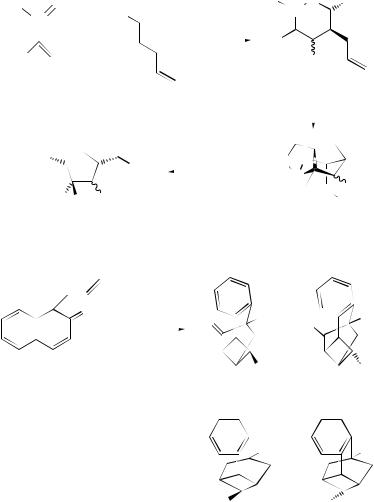
14 Addition Reactions: Cycloaddition |
|
|
|
|
|
|
|
|
|
|
|
|
|
|
|
|
|
|
|
455 |
||||||||||
− |
O |
|
|
O |
n |
O |
|
|
|
|
|
|
|
|
|
|
−O |
N+ |
O |
|
|
|
|
OBun |
||||||
|
|
|
|
|
|
|
|
|
|
|
|
|
|
|
|
|
|
|
|
|
|
|
||||||||
|
|
N+ |
Bu |
|
|
|
|
|
|
|
|
|
|
|
|
|
|
|
|
|
|
|
|
|
|
|||||
|
|
|
|
|
|
|
|
|
|
|
|
|
|
|
|
|
|
|
|
|
|
|
|
|||||||
|
|
+ |
|
|
|
|
|
|
|
|
|
|
|
|
|
|
|
|
|
|
|
|
|
|
|
|
|
|||
|
|
|
|
|
|
|
|
|
|
|
|
|
|
|
|
|
|
Me |
|
|
|
|
|
|
|
|
|
|||
Me |
|
|
|
|
|
SnCl4 |
|
|
Ph |
|
|
|
|
|
||||||||||||||||
|
|
|
|
|
|
|
|
|
|
|
|
|
|
|
|
|||||||||||||||
|
|
|
|
|
|
91−94% |
|
|
|
|
|
|
|
|
|
|
||||||||||||||
|
|
|
|
|
|
|
|
|
|
|
|
|
|
|
|
|
|
|
|
|
||||||||||
|
|
|
|
Ph |
|
|
|
|
|
|
|
|
|
|
|
|
|
|
|
|
|
|
|
|||||||
|
|
|
|
|
|
|
|
|
|
|
|
|
|
|
|
|
|
|
|
|
|
|
|
|
|
|
|
|
|
|
|
|
(9) |
|
|
(10) |
|
|
|
|
|
|
|
|
|
|
|
heat |
|
75−93% |
|||||||||||
|
|
|
|
|
|
|
|
|
|
|
|
|
|
|
|
|||||||||||||||
|
|
|
|
|
|
|
|
|
|
|
|
|
|
|
|
|
|
|
|
|
||||||||||
|
|
|
OAc |
|
|
|
|
|
|
|
|
|
|
|
|
|
|
|
|
|
|
|
|
|
|
|
|
|
|
|
|
|
|
|
|
|
|
|
|
|
|
|
|
|
|
|
|
|
|
|
|
|
|
|
|
|
|
|
|
||
|
|
|
|
|
|
OAc |
(a) Ra−Ni/NaBH4 |
|
|
O |
O |
|
|
|
|
|
||||||||||||||
|
|
|
|
|
|
|
|
|
|
|
|
|
||||||||||||||||||
|
|
|
|
|
|
|
|
|
|
|
|
|
|
|
|
|
N |
|
|
|
|
|
|
|
|
|
||||
|
|
|
|
|
|
|
|
|
(b) pyr/Ac2O |
|
|
|
|
|
|
|
|
|
|
Ph |
||||||||||
|
|
|
|
|
|
|
|
|
|
|
Me |
O |
|
|
||||||||||||||||
|
|
AcNH |
Me Ph |
|
|
|
|
|
50−53% |
|
|
|
|
|||||||||||||||||
|
|
|
|
|
|
|
|
|
|
|
Bun |
|||||||||||||||||||
|
|
|
|
|
|
|
|
|
|
|
|
|
|
|
|
|
|
|
|
|
|
|
|
|
|
|||||
|
|
|
|
|
(12) |
|
|
|
|
|
|
|
|
|
|
|
|
|
|
|
|
|
(11) |
|
|
|
||||
|
|
|
|
|
|
|
|
SCHEME 3 |
|
|
|
|
|
|
|
|
|
|
|
|
|
|||||||||
|
|
|
|
|
|
Ph |
|
|
|
|
|
|
|
|
|
|
|
|
|
|
|
|
|
|
|
|
|
|
||
|
|
Me |
|
|
|
|
|
|
|
|
|
|
|
|
|
|
|
|
|
|
|
|
|
|
|
|
|
|
||
|
|
|
|
|
O |
|
|
|
|
|
O |
|
Me |
+ |
|
|
O |
|
|
|
|
Me |
||||||||
|
|
|
|
|
|
|
|
hn |
|
|
|
|
|
|
|
|
|
|||||||||||||
|
|
|
|
|
|
|
|
|
|
|
|
|
|
|||||||||||||||||
|
|
|
|
|
|
|
|
|
|
|
|
|
|
|
|
|
|
Ph |
|
|
|
|
|
|
|
|
|
|
Ph |
|
|
|
(13) |
|
|
|
|
|
|
|
|
|
|
|
|
|
|
|
|
|
|
|
|
|
|
|
|||||
|
|
|
|
|
|
|
|
|
(14) |
|
|
|
|
|
|
|
|
|
|
(15) |
||||||||||
|
|
|
|
|
|
|
|
|
+ |
|
|
|
|
|
|
|
Me |
+ |
|
|
|
|
|
|
|
|
|
Me |
||
|
|
|
|
|
|
|
|
|
|
|
|
|
|
|
|
|
|
|
|
|
|
|
|
|
||||||
|
|
|
|
|
|
|
|
|
|
|
O |
|
|
|
|
|
|
|
|
O |
|
|
|
|
|
|
||||
|
|
|
|
|
|
|
|
|
|
|
|
|
|
|
|
|
|
|
|
|
|
|
|
|
|
|||||
|
|
|
|
|
|
|
|
|
|
|
Ph |
|
|
|
|
|
Ph |
|
|
|
||||||||||
|
|
|
|
|
|
|
|
|
|
|
|
|
|
|
|
|
|
|
|
|
|
|||||||||
|
|
|
|
|
|
|
|
|
(16) |
|
|
|
|
|
|
|
|
|
|
(17) |
||||||||||
SCHEME 4
A study of the stereochemistry and secondary isotope effects for the 2 + 2-cyclo- addition of alkyl-substituted buta-1,3-dienes with C60 indicates the formation of an open biradical intermediate in the rate-determining step leading to the cycloadduct (18) (Scheme 5).12 The addition of benzyne to C70 produces four isomeric monoadducts. One of these adducts is the first example of an adduct of a 5–6 ring fusion where the ring-fusion bond remains intact.13
A review of the mechanism of thermal 2 + 2-cycloadditions of activated alkenes to allenes and ketenes has been published.14 Stereoselective intramolecular 2 + 2- cycloadditions of alkene–keteniminium salts (19) derived from L-glutamic salts yield
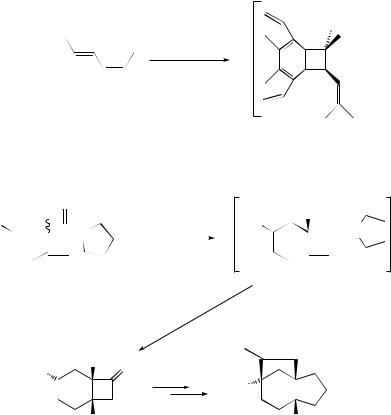
456 |
Organic Reaction Mechanisms 1998 |
optically active bicyclo[4.2.0]octan-7-ones (20) which can be converted into (+)-gibberellic acid intermediates (21) (Scheme 6).15 Ab initio calculations predict that the thermal 2 + 2-cycloaddition reactions between C2ν -symmetric ketenes and enantiopure aldehydes proceed with high stereocontrol.16 The influence of photoinduced electron-transfer steps in the regioand diastereo-specificity of Paterno–Buchi¨ reaction with 2,3-dihydrofuran in polar solvents has been demonstrated.17 The reaction of ethoxyacetylene with alkoxyaldehydes (22) in the presence of MgBr2 –Et2O yields 4-ethoxy-2H -oxetes (23), thus providing experimental evidence for a 2 + 2-cycloaddition mechanism (Scheme 7).18 The asymmetric 2 + 2-cycloaddition of silylketenes and aldehydes, in the presence of Ti–TADDOL catalysts, proceeds with good reactivity and moderate enantioselectivity.19 Ab initio and MNDO-PM3 treatment of the Wittig reaction of ylides with acetaldehyde indicate that the oxaphosphetane formation is a very asynchronous cycloaddition.20
C60 +
R2 O
R1O
N
R2
R1O
H
(20)
hn
toluene, 15 min
(18)
SCHEME 5
(1) Tf2O, base, |
R2 |
||||
|
R1O |
||||
CH2Cl2 |
|
|
• |
|
N+ |
|
|
|
|||
|
|
|
|||
(2) H2O, CCl4,
reflux
(19)
O
HO |
|
|
O |
|
|
||
|
|
|
|
|
H |
||
|
(21) |
|
|
SCHEME 6
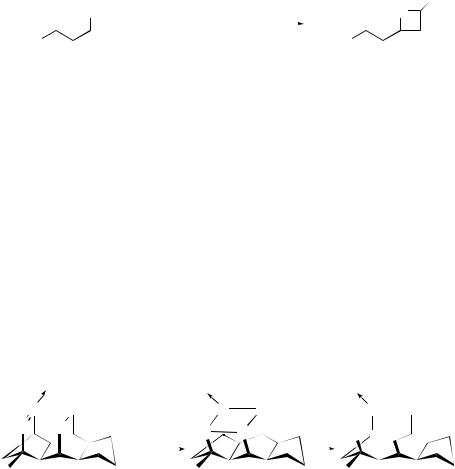
14 Addition Reactions: Cycloaddition |
|
457 |
|||||||
|
|
|
|
|
|
|
|
|
OEt |
OR O |
|
|
|
MgBr2−OEt2, 3 equiv. |
OR O |
|
|
||
|
|
|
|
||||||
|
+ |
|
|
OEt |
|
|
|
|
|
|
|
|
|
|
|
||||
|
|
|
CH2Cl2, 30 min, |
−60 °C |
|
|
|
||
C11H23 |
|
|
|
C11H23 |
|||||
|
|
|
|
|
|||||
(22) |
|
|
|
|
|
|
(23) |
|
|
R = Bn, Me |
|
|
|
|
|
|
|
|
|
SCHEME 7
A very remote secondary H/D isotope effect has been measured for the 2 + 2- cycloaddition of TCNE to 2,7-dimethylocta-2,trans-4,6-triene.21 The reaction of nitric oxide with N -benzylidene-4-methoxyaniline to produce 4-methoxybenzenediazonium nitrate and benzaldehyde is thought to proceed via a 2 + 2-cycloaddition between nitric oxide and the imine double bond.22 A novel mechanism for the stepwise dimerization of the parent silaethylene to 1,3-disilacyclobutane involves a low-barrier [1,2]- sigmatropic shift.23 Density functional, correlated ab initio calculations, and frontier MO analysis support a concerted 2 + 2-pathway for the addition of SO3 to alkenes.24
The enone cycloaddition reactions of dienones and quinones have been reviewed.25 The 2 + 2-photocycloadditions of homochiral 2(5H )-furanones to vinylene carbonate are highly diastereoisomeric.26
Monochromatic π, π excitation of the proximate (24) yielded the metathesis isomer (26) with retention of optical purity thus providing support for the π 2 + π 2-photo- cycloaddition pathway involving a tetrazetidine oxide intermediate (25) (Scheme 8).27
|
O |
|
|
O |
|
|
|
|
|
O |
|
|
|
|
|
|
|
|
|
|
|
|
|
|
|
|
|
|
|||
N |
N |
|
|
|
N |
N |
|
|
|
|
N |
|
|
N |
|
|
|
|
|
|
|
|
|
|
|||||||
|
|
|
|
|
|
|
|
|
|||||||
N |
N |
|
|
N |
|
|
N |
|
|
N |
|
|
|
N |
|
|
|
|
|
|
|
|
|
|
|
|
|||||
|
|
|
|
|
|
|
|
|
|
|
|||||
|
|
hn, 254 nm |
|
|
|
|
|
|
|
|
|
|
|
||
|
|
MeOH |
|
|
|
|
|
|
|
|
|
|
|
|
|
|
(24) |
|
|
|
|
|
(25) |
|
|
|
|
|
(26) |
||
|
|
|
|
|
|
|
|
|
|
|
|
|
10% |
||
|
|
|
|
SCHEME 8 |
|
|
|
|
|
|
|
|
|||
2 +3-Cycloaddition |
|
|
|
|
|
|
|
|
|
|
|
|
|
|
|
The 3 + 2-cycloaddition of 1,2- |
dithiophthalides with nitrilimines yields benzo[c]thio- |
||||||||||||||
|
|
28 |
The |
azomethineimines |
isoquinolinium- |
||||||||||
phenespirothiadiazoles regioselectively. |
|
|
|||||||||||||
N -aryllimide and N -(2-pyridyl)imide readily undergo 1,3-dipolar cycloaddition with electron-deficient dipolarophiles, dimethyl fumarate and dimethyl maleate, to yield tetrahydropyrazolo[5,1-a]isoquinolines in high yield.29,30 The 1,3-dipolar cycloadditions of electron-poor 1,3-dipoles, bicyclic azomethine ylides (27), with (E)-1-N ,N -dimethylaminopropene to yield cycloadducts (28) and (29) are examples of non-stereospecific cycloadductions (Scheme 9).31 The synthesis of protected

458 |
Organic Reaction Mechanisms 1998 |
2,3-didehydro-4,5-methano amino acids (31) involves the π -diastereoselective 1,3- dipolar cycloaddition of diazomethane with chiral furanones (30) derived from D- glyceraldehyde acetonide as the only chiral precursor (Scheme 10).32
|
|
Me |
Me |
|
|
|
|
|
|
R |
|
NC |
|
+ N |
|
− |
|
|
|
C |
|
N |
|
|
|
NC
R
(27)
R = p-tolyl
CH3CN, 20 °C Me2N |
|
H |
HMe
NC |
|
|
|
|
|
Me |
|
NC |
|
|
Me |
||||||
|
|
N |
R Me |
|
|
N |
|
R Me |
|||||||||
NC |
N |
|
NC |
N |
|
||||||||||||
|
|
|
|
|
|
|
|
|
|||||||||
H |
H |
R |
+ |
|
|
H |
Me |
R |
|
|
|
||||||
Me2N |
|
|
|
|
|
|
|
|
|
|
Me2N |
|
|
|
|
|
|
|
Me |
|
|
|
|
|
|
|
|
|
|
H |
|
|
|
|
|
|
|
|
52 |
|
: |
|
|
|
|
|
48 |
|
|
|
|||
|
|
|
(28) |
|
|
|
|
|
|
|
|
|
(29) |
|
|
|
|
|
|
|
|
|
|
|
|
SCHEME 9 |
|
|
|
|
|
||||
TBDPSO |
|
|
|
O |
O |
|
TBDPSO |
|
O |
O |
|||||||
|
|
|
|
|
|
|
CH2N2 |
|
|
|
|
|
|||||
|
|
|
|
|
|
|
ether 100% |
|
|
|
H |
|
|
H |
|||
|
|
|
|
|
|
|
|
|
|
|
|
||||||
|
|
|
(30) |
|
|
|
|
|
|
|
|
|
N |
N |
|||
|
|
|
|
|
|
|
|
|
|
|
|
|
|
|
|
||
|
|
|
|
|
|
|
|
|
|
|
|
|
|
|
|
||
|
|
|
|
|
|
|
|
|
|
|
|
|
|
−4 ˚C |
|
hn, Pyrex |
|
|
|
|
|
|
|
|
|
|
|
|
|
|
|
86% |
|
|
toluene |
MeO2C |
|
|
|
|
|
|
|
|
|
|
|
|
|
|
|
|
|
|
|
|
|
|
CO2Me |
|
TBDPSO |
|
O |
O |
|||||||
RHN |
|
|
|
|
|
|
H |
|
|
H |
|||||||
|
|
|
|
|
|
|
|
||||||||||
|
|
|
|
|
|
|
|
|
|
|
|
|
|
|
|||
|
|
|
|
|
|
|
|
|
|
|
|
|
|
|
|||
H |
|
|
|
H |
|
|
|
|
|
||||||||
|
|
|
|
|
|
|
|
|
|
|
|||||||
|
(31) |
|
|
|
|
|
|
|
|
|
|
|
|
|
|
||
SCHEME 10

14 Addition Reactions: Cycloaddition |
459 |
The reaction of 5(4H )-oxazolones (32) and munchnones¨ with triphenylvinylphosphonium bromide (33) provides a mild synthesis of substituted pyrroles (34) (Scheme 11).33 The cycloaddition–elimination reactions of 5-imino-1,2,4- thiadiazolidin-3-ones with enamines and ester enolates produce 2-iminothiazolidines.34 Chiral isomunchnone¨ dipoles show π -facial diastereoselectivity with N -phenyl- or N -methyl-maleimide in refluxing benzene.35
−O |
|
|
|
|
|
|
|
|
|
|
|
|
|
|
|
|
|
|
|
|
|
|
|
|
|
|
|
|
|
|
O |
|
+ |
|
|
|
|
|
|
|
|
|
|
|
|
|
|
|
|
|
|
|
|
|
|
|
|
|
|
+ |
PPh3 |
|
|
|
reflux |
|
|
|
|
|
|
|
|
|
|
|
|
|
|
|
|||
|
|
N+ |
Br− |
|
THF/CH2Cl2 |
|
|
|
|
N |
|
|
|
|
|||||||||||||
R1 |
R2 |
|
R1 |
R2 |
|||||||||||||||||||||||
|
|
|
|
|
|
|
|
|
|
|
|
|
|
|
|
|
|
|
|
|
|
|
|
|
|
|
|
|
|
H |
|
|
|
|
|
|
|
|
|
|
|
|
|
|
|
|
H |
|
|
|
|
||||
(32) |
|
(33) |
|
|
|
|
|
|
|
|
|
|
(34) |
40% |
|
|
|
|
|||||||||
R1 |
|
|
R2 |
|
|
|
|
|
|
|
|
|
|
|
|
|
|
|
|
|
|
|
|
|
|
|
|
Ph |
|
|
Ph |
|
|
|
|
|
|
|
|
|
|
|
|
|
|
|
|
|
|
|
|
|
|
|
|
4-ClPh |
|
|
Ph |
|
|
|
|
|
|
|
|
|
|
|
|
|
|
|
|
|
|
|
|
|
|
|
|
Ph |
|
|
4-ClPh |
|
|
|
|
|
|
|
|
|
|
|
|
|
|
|
|
|
|
|
|
|
|
|
|
4-MePh |
Ph |
|
|
|
|
|
|
|
|
|
|
|
|
|
|
|
|
|
|
|
|
|
|
|
|||
Ph |
|
|
4-MePh |
|
|
|
|
|
|
|
|
|
|
|
|
|
|
|
|
|
|
|
|
|
|
|
|
Ph |
|
|
i-Pr |
|
|
|
|
|
|
|
|
|
|
|
|
|
|
|
|
|
|
|
|
|
|
|
|
i-Pr |
|
|
Ph |
|
|
|
|
|
|
|
|
|
|
|
|
|
|
|
|
|
|
|
|
|
|
|
|
|
|
|
|
|
SCHEME 11 |
|
|
|
|
|
|
|
|
|
|
|
|
|
|
|
|
|
|||||
OAc |
OAc |
O |
|
|
|
|
|
|
|
|
|
|
|
|
|
|
|
−O |
|
|
|
|
|||||
|
|
|
|
|
|
|
|
|
|
|
|
|
|
|
|
|
|
|
|||||||||
|
|
|
|
|
|
|
|
|
|
|
|
|
|
|
|
|
N+ |
|
|
|
|||||||
|
|
|
|
|
|
|
|
|
|
|
|
|
|
|
|
|
|
|
|
|
|
|
O |
||||
AcO |
|
|
|
N+ |
|
|
|
|
|
|
EtOH |
|
|
|
|
|
|
|
|
|
|||||||
|
|
|
|
|
|
|
|
|
|
|
|
|
|
|
|
|
|
||||||||||
|
|
|
|
|
O− + |
|
|
|
OEt |
|
|
|
|
|
|
|
|
|
|
|
|
|
|
|
|
|
|
OAc |
OAc |
|
|
25 |
°C, 5−7 d |
|
|
|
|
|
|
|
|
|
|||||||||||||
|
|
|
|
|
|
|
|
|
|
|
|
|
|
|
|||||||||||||
|
|
|
|
|
|
|
|
|
|
|
|
|
|
|
|
|
|
|
|
|
OEt |
||||||
|
|
(35) |
|
|
|
|
|
|
|
|
|
|
|
|
|
|
|
AcO |
|
H |
|||||||
|
|
|
|
|
|
|
|
|
|
|
|
|
|
|
|
|
|
|
|
|
|||||||
|
|
|
|
|
|
|
|
|
|
|
|
|
|
|
|
|
|
|
|
|
|
R* |
|||||
CO2Me |
|
|
|
MeO2C |
|
|
|
|
|
|
|
|
|
|
|
|
|
|
|
|
|
(36) |
|
|
|||
|
|
|
|
|
|
|
|
|
|
|
|
|
|
|
|
|
|
|
|
|
|
||||||
|
|
|
|
|
|
|
|
|
|
|
|
|
|
|
|
|
|
|
|
+ |
|
|
|
||||
O |
|
|
|
|
O |
|
|
|
|
|
|
|
|
|
|
|
|
|
|
|
|
|
|
|
|
||
H N |
|
O |
H |
|
|
N |
|
O H |
|
|
|
|
|
|
|
|
|
|
|
|
|
|
|
||||
|
|
|
|
|
|
|
|
|
|
|
|
|
|
|
|
|
|
|
|||||||||
|
|
|
|
+ |
H |
|
|
|
|
|
|
|
|
|
|
|
|
|
|
|
|
|
CO2Me |
||||
|
|
|
|
|
|
|
|
|
|
|
|
|
|
|
|
|
|
|
|
|
|||||||
|
|
|
|
|
|
|
|
|
|
|
|
|
|
|
|
|
|
|
|
|
|||||||
|
|
|
|
OEt |
|
|
|
|
|
|
OEt |
|
|
|
|
|
|
|
|
||||||||
|
|
|
|
|
|
|
|
|
|
|
|
|
|
|
|
|
|
|
|
|
|
||||||
AcO |
H |
|
AcO |
|
|
H |
|
|
|
|
|
|
|
|
|
|
|
|
|
|
|
|
|
||||
R* |
|
|
|
|
R* |
|
|
|
|
|
|
|
|
|
|
|
|
|
|
|
|
|
|||||
(38) 4% |
|
|
(37) 75% |
|
|
|
|
|
|
|
|
|
|
|
|
|
|
|
|
|
|||||||
|
|
|
|
|
R* = D-lyxo-(CHOAc)3CH2OAc |
|
|
|
|
|
|
|
|
|
|
|
|
||||||||||
SCHEME 12

460 |
Organic Reaction Mechanisms 1998 |
The asymmetric tandem cycloaddition of the chiral carbohydrate nitroalkene (35) with ethyl vinyl ether involves the initial formation of the nitronate (36) which reacts exclusively with electron-withdrawing alkenes by 3 + 2-cycloaddition to yield chiral bicycles (37) and (38) (Scheme 12).36
Intramolecular 3 + 2-photocycloadditions of alkenyl methyl 1,4-naphthalenedicarb- oxylates (39) yield 3 + 2-cycloadducts (40) having 9–11-membered ring systems in addition to the characteristic five-membered ring structure (Scheme 13).37
The 1,3-dipolar cycloaddition of fluorenethione S-oxide (41) and trans-octene yields the corresponding sultine (42) which readily converts olefins to episulfides (Scheme 14).38
|
|
|
|
|
|
|
|
|
|
|
|
O |
||
|
|
|
|
|
|
|||||||||
O |
O |
O |
|
|
|
|
|
|
|
|
|
n |
||
|
|
|
|
|
|
|
|
|
|
O |
||||
|
|
|
n |
|
|
|
|
|
|
|
|
|||
|
|
|
|
|
|
|
|
hn |
|
|
|
|
||
|
|
|
|
|
|
|
|
|||||||
|
|
|
|
|
|
|
n = 3, 4, 5 |
|
|
|
|
|
|
|
|
|
|
|
|
|
|
|
|||||||
|
|
|
|
|
|
|
C6H6 |
|||||||
|
CO2Me |
|
|
|
|
|
|
|
MeO2C H |
|||||
|
(39) |
|
|
|
(40) |
|
|
|||||||
|
|
|
|
|
|
SCHEME 13 |
||||||||
|
|
|
|
O |
|
|
|
|
|
|
O |
|||
|
|
|
S |
|
|
|
|
|
|
S |
||||
|
|
|
|
|
|
|
|
|
|
|
|
|||
+ |
|
|
|
|
|
|
|
K2CO3 |
||||||
|
|
|
|
|
|
|
|
|
|
|
|
|
|
|
|
|
|
|
|
|
|
CHCl3 |
|||||||
|
|
|
|
|
|
|
|
|||||||
|
|
|
|
|
|
|
|
reflux, 16 h |
||||||
|
|
|
(41) |
|
(42) |
|||||||||
|
|
|
|
|
|
SCHEME 14 |
||||||||
A study of the regioselectivity of the 1,3-dipolar cycloaddition of aliphatic nitrile oxides with cinnamic acid esters has been published.39 AM1 MO studies on the gasphase 1,3-dipolar cycloaddition of 1,2,4-triazepine and formonitrile oxide show that the mechanism leading to the most stable adduct is concerted.40 An ab initio study of the regiochemistry of 1,3-dipolar cycloadditions of diazomethane and formonitrile oxide with ethene, propene, and methyl vinyl ether has been presented.41 The 1,3- dipolar cycloaddition of mesitonitrile oxide with 4,7-phenanthroline yields both monoand bis-adducts.42 Alkynyl(phenyl)iodonium triflates undergo 2 + 3-cycloaddition with ethyl diazoacetate, N -t -butyl-α-phenyl nitrone and t -butyl nitrile oxide to produce substituted pyrroles, dihydroisoxazoles, and isoxazoles respectively.43 2β- Vinyl-trans-octahydro-1,3-benzoxazine (43) undergoes 1,3-dipolar cycloaddition with nitrile oxides with high diastereoselectivity (90% de) (Scheme 15).44
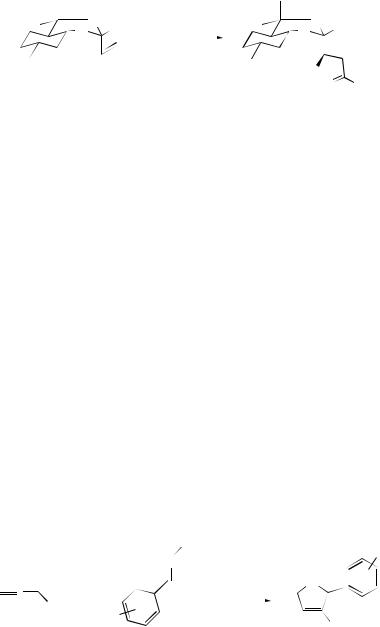
14 Addition Reactions: Cycloaddition |
|
461 |
||||||||
NTs |
H |
− |
+ |
|
|
|
|
NTs |
H |
|
O |
|
|
|
|
|
|
|
O |
||
O |
|
N |
|
C Me |
||||||
|
|
|
|
|||||||
|
|
|
75% |
|
|
|
|
|||
(43) |
|
|
|
|
|
|
|
|
O |
|
|
|
|
|
|
|
|
|
|
N |
Me |
|
|
|
|
|
|
|
|
|
90% de |
|
SCHEME 15
The 1,3-dipolar cycloadditions of benzonitrile oxides with tertiary cinnamides yield the 5-phenyl and 4-phenyl regioisomers in a reversal of the expected regioselectivities shown with methyl cinnamate. Calculations have shown that steric factors are responsible for this reversal of regioselectivity.45 The 1,3-dipolar cycloadditions of benzonitrile oxide with electron-rich and electron-poor dipolarophiles are accelerated by sodium dodecyl sulfate micelles.46 Phenyl nitrile ylides react with electron-deficient alkenes to produce five-membered N -heterocycles where measured rate constants are between 4 × 105 and 7 × 109 l mol−1 s−1.47
The reaction of buta-2,3-dienoates (44) with electron-deficient imines (45) in the presence of triphenylphosphene yields 3 + 2-cycloadducts (46) in excellent yields and high chemoselectivity (Scheme 16).48 The 1,3-diaza-2-azoniaallene salts (47) react with alkynes, N ,N -dialkylcarbodiimides, and N ,N -dialkylcyanamides to produce 1,2,3-triazolium salts, 1,3,4,5-tetrasubstituted 4,5-dihydrotetrazolium salts, and 1,3,5- trisubstituted tetrazolium salts, respectively (Scheme 17).49
For the first time, DFT theory has been applied to a study of diastereofacial selectivity in 1,3-dipolar cycloadditions of nitrones to cis-3,4-dimethylcyclobutene.50 The stereochemical outcome of the INAC reactions of nitrones (49) and (52) derived from 3-O-allyl-D-hexoses is dependent only on the relative configuration at C(2,3), and thus 3-O-allyl-D-glucose (48) and -D-altrose (threo configuration) afford oxepanes (50) selectively whereas 3-O-allyl-D-allose (51) and -D-mannose (erythro configuration) give tetrahydrofurans (53) and (54) selectively (Scheme 18).51 trans-2-Methylene- 1,3-dithiolane-1,3-dioxide (55) reacts regiospecifically with acyclic and cyclic nitrones (56) to produce 4,4- (57) rather than 5,5-disubstituted isoxazolidines (Scheme 19).52
|
Ts |
R |
||
N |
Ts |
|||
|
||||
|
|
|
|
|
N
• |
|
CO2Me |
+ |
|
Ph3P |
|
|
||||
|
|
|
benzene, r.t. |
||
|
|
|
|
R |
|
CO2Me
(44) |
(45) |
(46) |
R = H, 2-MeO, 4-MeO,
4-Me, 4-Cl, 4-NO2
SCHEME 16
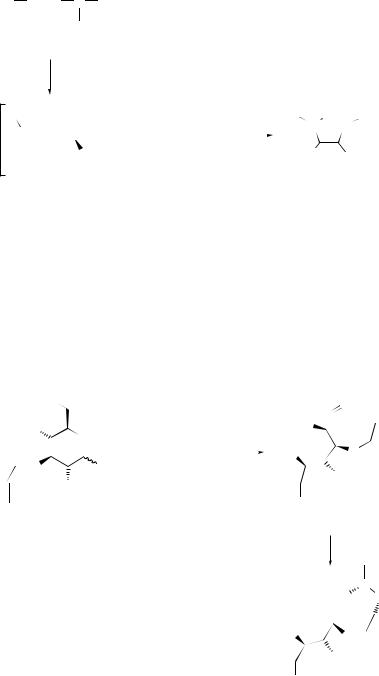
462 |
Organic Reaction Mechanisms 1998 |
R1 N  N N R2
N N R2
Cl
R1 = 2,4,6-Cl3C6H2
SbCl5, CHCl3, −78 °C
R1 |
|
|
|
|
|
|
|
|
|
|
R1 |
|
N |
R2 |
||
+ |
|
|
|
|
|
R3 |
|
|
|
R4 |
N + |
N |
||||
|
|
|
|
|
|
|
||||||||||
|
|
|
|
|
|
|
||||||||||
|
|
|
|
|
|
|
||||||||||
• |
|
|
|
• |
|
|
|
|
|
|
|
|
|
|
|
|
• N |
|
N |
|
N • |
R2 |
|
CH2Cl2, −78 to 23 °C , 1 h, 27−83% |
|
|
X− |
||||||
|
|
|
X− |
|
R3 |
R4 |
||||||||||
|
|
|
|
|
|
|
|
|
|
|||||||
|
|
|
|
|
|
|
|
|
|
|
|
X = SbCl6 |
||||
|
|
|
|
|
|
|
|
|
|
|
|
|
|
|||
(47)
R3 R4
HH
Bu |
H |
But |
H |
CH2OH |
H |
Et |
Et |
CH2Cl |
CH2Cl |
Me |
Ph |
Ph |
Ph |
CO2Me |
CO2Me |
|
|
|
SCHEME 17 |
|
|
|
|
|
|
|
|
|
|
|
Me |
||||
HO |
|
|
|
|
|
|
|
O− |
|
|
|
|
|
N |
|||||
|
|
|
|
|
+ |
|
|||
HO |
O |
|
|
HO |
|
|
|
|
|
|
|
|
|
|
|
|
|||
|
|
|
|
|
|
|
|
||
|
|
MeNHOH.HCl, NaHCO3, |
|
|
|
|
|
||
|
|
|
|
O |
|||||
|
|
|
|
HO |
|
||||
|
|
|
|
||||||
O |
|
|
80% EtOH (aq.), reflux, 48 h |
|
|
|
|
|
|
|
OH |
OH |
|
|
|
||||
OH |
|
|
|
|
|
|
|
||
|
|
|
|
|
|
|
|
|
|
|
|
|
|
OH |
|
|
|
|
|
(48) |
|
|
|
|
(49) |
|
|
|
|
Me
N
HO
 O
O
HO O
OH
OH
(50)
